1920's Family Photography Glamour and "Red Dress"

Spirit photo by Édouard Isidore Buguet
Spirit photography (as well chosen ghost photography) is a type of photography whose primary goal is to capture images of ghosts and other spiritual entities, especially in ghost hunting. It dates back to the late 19th century. The finish of the American Civil State of war and the mid-19th Century Spiritualism motion contributed greatly to the popularity of spirit photography. Photographers such as William Mumler and William Promise ran thriving businesses taking photos of people with their supposed dead relatives. Both were shown to be frauds, merely "true believers", such as Sir Arthur Conan Doyle, refused to accept the bear witness as proof of a hoax.
As cameras became bachelor to the full general public, ghost photographs became mutual due to natural photographic camera artifacts such as flash reflecting off dust particles, a camera strap or pilus shut to the lens, lens flare, pareidolia, or in modernistic times, deceptions using smart phone applications that add ghosts images to existing photographs.
History [edit]
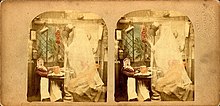
The-Ghost-in-the-Stereoscope-Stereoview-Card
The kickoff applied photography, introduced in 1839, used the process called daguerreotype, and spirits were never captured.[1] According to Owen Davies in The Haunted: A Social History of Ghosts, ghost photography started with photographic experimentation using people standing in forepart of and behind glass windows or noting that the long exposures required at the time would often result in transparent images when people or animals left the frame during the exposure. Sir David Brewster, in 1856, recognized that these furnishings could exist used to deliberately create ghostly pictures. The London Stereoscopic Company decided to use Brewster's idea and created a serial of images called "The Ghost in the Stereoscope".[2] Simply it was non until drinking glass plate negatives were used circa 1859, making double images possible, that spirits began to regularly appear in photographs.[1]
From the 1860s on, the spirit photographers were no longer using the long exposures and double images previously used but instead what looked like cut out faces and bodies from magazines to stand for disembodied figures.[2] By the 1880s, equally more people owned cameras, spirit photography boomed.[3] It didn't first to turn down until the 1920s after skeptics such as Harry Houdini tried to annul spiritualistic fraud.[1]
Spirit photographers [edit]
An American jewelry engraver and apprentice photographer named William Mumler published, in 1862, a photograph of what was purportedly the spirit of his cousin, who had died 12 years earlier. The media sensation that this caused, led Mumler to go out engraving and to begin a successful business organisation every bit a "Spirit Photographic Medium", which he set upwards in New York and Boston servicing those hoping to find a supernatural connection with relatives killed in the American Civil State of war.[ii] [3]
1 of Mumler'due south well-nigh famous images is a photograph of Mary Todd Lincoln posed with the purported spirit of her assassinated husband.[4] The apparent spirits that Mumler had captured were double exposures of previous clients from photographic plates that were improperly cleaned.[five] In 1869, Mumler's fraud was discovered and he was charged. He was acquitted, however, despite the testify provided that one of his so-called spirits was shown to exist nonetheless alive.[2] P.T. Barnum, who testified against Mumler, was 1 of his outspoken critics, declaring he was taking advantage of people's grief. Mumler later moved on to doing regular photography.[three]
Credible ghost photographs taken past William H. Mumler
-

The original self portrait of William Mumler allegedly featuring the ghost of his cousin
-
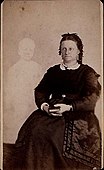
Circa 1868
-

Circa 1871
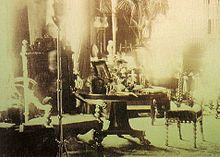
This photograph of the Library in Combermere Abbey was taken past Sybell Corbet in 1891
Spirit photography started appearing in England in 1872 from photographer Fredrick Hudson's studios.[2] He allegedly "gimmicked" his camera to agree a pre-exposed epitome that would move into place when he took his photograph.[4]
In 1875, Édouard Buguet, a French spirit photographer, who also had a studio in London, was arrested in Paris and prosecuted for fraud after making a full confession. He false spirits by wrapping dolls in gauze and attaching photos of faces onto them. His confession was widely publicized in the French and English language press.[2]
In 1891 one of the almost famous spirit photographs was taken by Sybell Corbet. She took a photo of the library at Combermere Abbey in Cheshire, England in which appeared the "...faint outline of a man's caput, neckband and right arm". The figure was believed to be the ghost of Lord Combermere who had recently died and was being buried at the fourth dimension the photo was taken. Because the exposure was i hour, it was believed by skeptics that someone, possibly a servant, had walked into the room and paused, causing the ghostly outline.[3]

One of the most famous photographers at the turn of the century was William Promise. In Feb 1922, Harry Toll from the Social club for Psychical Research, a magician named Seymour, Eric J. Dingwall and William S. Marriott showed Hope to be a fraud. They devised a programme where they presented Hope with glass negatives that had secretly been marked with X-rays. The returned plate containing the spirit had no markings. Price wrote his findings in the Journal of the Guild for Psychical Research. Despite this proof, prominent spiritualists, such as Arthur Conan Doyle, claimed the written report was a part of a conspiracy against Promise.[six] Promise had continued success despite the bear witness against him.[3] Paranormal investigator Massimo Polidoro said that the case of William Hope and his followers demonstrate how difficult information technology can be to convince true believers, fifty-fifty when there is strong show of fraud.[6]
Other spirit photographers exposed as frauds include David Duguid and Edward Wyllie.[vii] [8] Ronald Pearsall exposed the tricks of spirit photography in his book The Table-Rappers (1972).[9]
Early books [edit]
There were several books published defending the possibility of spirit photography. Amidst the notable books were The Case for Spirit Photography by Arthur Conan Doyle, published in 1922 where Doyle attempted to defend William Hope and his Crewe Circumvolve, a well known spiritualist group of the time.[10] Other spiritualists who authored books supporting spirit photography were Georgiana Houghton who wrote Chronicles of the Photographs of Spiritual Beings and Phenomena Invisible to the Material Eye (1882) and James Coates who wrote Photographing the Invisible (1911).[xi] [12]
Ghost photography [edit]
Paranormal investigator Joe Nickell makes a distinction between spirit photography and ghost photography in his book The Science of Ghosts: Searching for Spirits of the Expressionless, stating that spirit photography began in studios and eventually included ghosts photographed in séance rooms, whereas ghost photographs were taken in places that were considered haunted. Nickell states "...whereas spirit photos were invariably charlatans' productions, ghost photos could either be faked or appear inadvertently - every bit by reflection, accidental double exposure, or the similar."[4]
Once portable cameras became available to amateurs towards the end of the 1880s ghost photos became more frequent. In more modern times, cameras with built in flashes produced what some believed to be ectoplasm, or "orbs".[4] Most ghost photos fall into 1 of two categories. They are either hazy, indistinct shapes that expect man or orbs that are commonly white and round. Both can easily be purposefully or accidentally created.[thirteen] [14]
Modern claims [edit]
Photograph anomalies have always been present in photography but in the 1990s boob tube shows such as Ghost Hunters claimed the abnormalities represented proof of the afterlife. In his volume Investigating Ghosts: The Scientific Search for Spirits Ben Radford states that most evidence of ghosts in photographs or video are "...cursory, cryptic anomalies recorded with low-quality camera (or good-quality cameras sabotaged by low light conditions)." Radford believes that with camera engineering advancing, especially with smart phones, in that location should be clearer, sharper images of ghosts. Merely the photos remain low quality and vague.[5]
"Orbs" [edit]
And so what would exist proficient photographic proof of ghosts? An accurate photograph of anyone born before the invention of photography would be a good kickoff: Benjamin Franklin, William Shakespeare, or any of thousands of other people for whom we accept a skilful record of their likeness but no photograph. Just 1 such photo would be more convincing than a one thousand glowing blobs. Unfortunately, all the ghost photos offered then far are indistinguishable from intentional fakes and optical mistakes.
Benjamin Radford, Skeptical Inquirer, Ghost Photos:Scams, Slipups, and Spirits, November 3, 2006
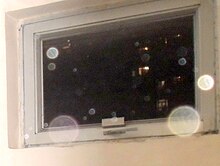
Calorie-free reflecting off dust particles
Co-ordinate to University of Westminster professor Annette Loma, unusual low-cal sources were often interpreted as "ghost lights" in spirit photography. Hill says that with the appearance of digital photography, "the ghost light is re-imagined every bit an orb", and many paranormal-themed websites evidence pictures containing visual artifacts they refer to every bit "orbs" that are claimed and debated as evidence of spirit presence, especially among ghost hunters.[xv] [16] [17] [18]
Withal, such common visual artifacts are simply a result of flash photography reflecting light off solid particles, such as grit, pollen, insects or liquid particles, particularly rain, or fifty-fifty foreign material within the camera lens. These effects are especially mutual with modern compact and ultra-compact digital cameras. Fujifilm describes the artifacts as a common photographic problem.[19] [20] [8] [21]
Causes for apparent ghost photographs [edit]
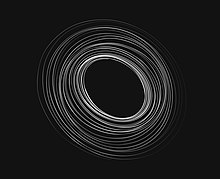
A circular shape created using light painting

Insect flights in the night in front of a spotlight HP L7869
According to Kenny Biddle and Joe Nickell in their article And then You Have a Ghost In Your Photo, "Asserting that a detail image must be paranormal because it is unexplained only constitutes an example of the logical fallacy chosen arguing from ignorance." They explain that the flash reflecting off a camera strap tin produce a bright, white strand or a "spiralling vortex of spirit energy" depending upon the textile the strap is made from. Other ghostly images tin result from strands of pilus, jewelry or flying insects. A flash illuminating a person's breath, in cold weather, cigarette smoke or fog tin wait like "ectoplasmic mist". Long exposures, usually several seconds, tin crusade ethereal, meet-through shapes or streaks of lines caused when the camera moves or if the object moves during the exposure.[1]
Ben Radford, in his book "Large - If True: Adventures in Oddity" includes the phenomenon called pareidolia, the trend for people to see faces or animals in things such as clouds, tree trunks or nutrient, every bit an explanation for finding ghosts in photographs. Shadows from trees, uneven surfaces, reflections of light from h2o or glass can all make us run into "faces". He notes that a ghosts elbow or foot are rarely reported.[xiii]
Mod ghost photographs [edit]
In 2016, tourist Henry Yau took a picture of a staircase with a ghostly figure inside the Stanley Hotel in Colorado. The hotel is well known for its apparent hauntings. Several amateur ghost hunters believe the photo to exist unexplainable and believe that a ghost or possibly two ghosts are at the summit of the stairs. According to paranormal investigator Kenny Biddle, the "ghosts" could have been created considering the camera was in panorama mode, which takes several seconds, and which can cause a double image from the longer exposure. Biddle believes that the epitome represents the same person moving on the stairs. Ben Radford indicates that the style the adult female on the stairs is dressed and the location add to the possibility that people will jump to the conclusion that the paranormal is at work. He states "she seems to be wearing a archetype black or dark dress (as befits a fancy, well-known hotel); had she been wearing a yellow blazer and carrying a large Target shopping pocketbook speculations virtually her spectral origins would likely have been scuttled."[22]
According to Biddle, writer Tim Scullion claims that he has taken pictures of ghosts. Biddle explains that Scullion'southward ghosts are produced by using long exposures showing motility blur, lite painting, dust particles catching light, lens flare, or by overlaying blurry faces on a night scene. This overlay was conspicuously evident due to the lack of paradigm noise where the faces announced, compared to the residuum of the photo.[23]
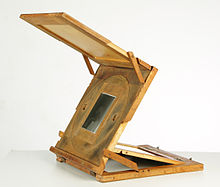
Retouching Desk circa 1870-1950
An old photo taken in 1900 became popular inside the paranormal community after it was posted on the website Belfast.co.uk in 2016 in a history section about old Belfast trades. The photo shows a group of Ulster girls from a linen factory. There is a mysterious, apparent ghostly hand sitting on the shoulder of i of the girls. The mitt does not appear to vest to anyone in the moving picture. Biddle decided the photo was authentic and provides evidence that someone was near likely removed from the photo in his article The 'Ghost Hand' Of 1900 in Skeptical Inquirer. He describes how retouching photos by manus using a retouching desk, cutting out objects and people, so filling them in with pencil or charcoal was not uncommon.[24]
On August eighteen, 2020 a security firm received an alert at a structure site in Birmingham, England. On the monitor appeared the "ghostly" figure of a lone woman in a white dress walking across the property. The paradigm went "viral"[ clarification needed ] and appeared in many tabloids such as the Mirror. Adam Lees, the managing managing director of a security firm who received the alert, stated "She'due south leaning forrad and seems to be floating, and is holding something in her hands. To me information technology looks like she is wearing a hymeneals apparel similar she'southward waiting to get married. She looks like a ghostly bride." Biddle noted some unusual things with the image. The camera level seemed likewise low for a security camera, in that location were no dates or times on the paradigm as would normally be seen from security software, and the image was in colour except for the area effectually the woman. Biddle surmised that the camera was in an infrared dark vision mode and a wink was fired, explaining the overexposure of the figure and the color baloney. Biddle reached out to Stewart Chapman, who had installed a permanent closed-circuit boob tube system to a higher place the other system, and had posted ii screen shots of a girl in a ruddy apparel showing information technology was not a ghost on the property simply a drunken girl and her friend.[25]
Ghost camera apps [edit]
Smartphone applications that place images of ghosts, aliens and monsters into bodily pictures have been used for pranks or to try to fool people into thinking they are real images of ghosts. The apps are customizable allowing the user to place the ghost anywhere within a photo, rotate it, adjust its transparency, and erase parts. In 2014, at that place were over 250 ghost related applications for Android phones, 1 of the about pop beingness GhostCam: Spirit Photography. This app was used in a hoax that was used to generate publicity. The group named Ghosts of New England Research Order began publishing hoaxed ghost photos equally accurate, hoping to promote an episode of Discovery Channel's American Haunting that the grouping appeared in. The photo showed a ghostly figure in a eating house. Biddle spotted the forgery on Facebook and noticed that the "ghost" looked similar a well documented photo called The Madonna of Bachelor's Grove taken by the Ghost Research Society in 1991. It is unclear if the Ghosts of New England Inquiry Guild posted the photos knowing they were hoaxes or if they were fooled by the restaurant owner who sent them the photograph. Information technology was adamant that the app was using The Madonna of Available's Grove without permission and was removed after this incident.[26]
Another app chosen Ghost Camera Prank was used by a ghost tour grouping Facebook page, challenge a client had taken information technology. Tkay Anderson, co-founder of the Facebook page There's a (ghost) App For That was able to discover the specific ghost used in the faked photograph. Other clues were that the "ghost" was sharper than the rest of the picture, the ghost was black and white while the remainder of the picture was in color and the ghost was calculated to be about eleven anxiety tall.[26]
Equally of 2018, the appeal and novelty of the Ghost cam apps has begun to wear off, although in that location are still people who will attempt to laissez passer off the results of these apps every bit authentic. Pranksters will effort to fool their friends or families but sometimes the prank can go likewise far when their targets believe the hoax is true. Others, such as the owners of pubs, hotels or ghost hunting tours will effort to profit from the photos by increasing their clientele or raising their prices.[27]
See also [edit]
- Kirlian photography
- Subconscious mother photography
- Spiritualist art
- Thoughtography
References [edit]
- ^ a b c d Biddle, Kenny; Nickell, Joe (August 2020). "So You lot Have A Ghost In Your Photo". Skeptical Inquirer. Archived from the original on July 15, 2020. Retrieved January twenty, 2021.
- ^ a b c d e f Davies, Owen (2007). The Haunted: A Social History of Ghosts. Houndsmills, Basingstoke, Hampshire and New York: Palgrave MacMillan. pp. 201–204. ISBN978-1-4039-3924-1.
- ^ a b c d e Timberlake, Howard (June 30, 2015). "The intriguing history of ghost photography". BBC. Archived from the original on Dec 24, 2019. Retrieved January 16, 2021.
- ^ a b c d Nickell, Joe (2012). The Scientific discipline of Ghosts: Searching for Spirits of the Dead. New York: Prometheus Books. pp. 297–305. ISBN978-1-61614-585-9.
- ^ a b Radford, Benjamin (2017). Investigating Ghosts: The Scientific Search for Spirits. U.s.a. of America: Cataloguing-in-Publication Information. pp. 124–143. ISBN978-0-9364-5516-7.
- ^ a b Polidoro, Massimo (August 2011). "Photos Of Ghosts: The Brunt Of Believing The Unbelievable". Skeptical Inquirer. Archived from the original on August 12, 2020. Retrieved January eighteen, 2021.
- ^ Nickell, Joe (2001). Real-Life X-Files: Investigating the Paranormal. Kentucky: The University Printing of Kentucky. pp. 260–261. ISBN9780813122106.
- ^ a b Nickell, Joe (2005). Camera Clues: A Handbook for Photographic Investigation. Kentucky: The Academy Press of Kentucky. p. 151. ISBN9780813191249.
- ^ Pearsall, Ronald (1972). The Table-Rappers: The Victorians and the Occult. Volume Gild Associates. pp. 118–125. ISBN9780718106454.
- ^ "The Example for Spirit Photography - The Arthur Conan Doyle Encyclopedia". www.arthur-conan-doyle.com . Retrieved 2021-01-eighteen .
- ^ Houghton, Georgiana (1882). Chronicles Of The Photographs Of Spiritual Beings.
- ^ Coates, James (1911). Photographing the Invisible. Duke University Libraries. Chicago, Ill., Advanced thought pub. co.
- ^ a b Radford, Benjamin (2020). Big-If True: Adventures in Oddity. New United mexican states, USA: Rhombus Publishing Company. p. 100. ISBN978-0-9364-5517-4.
- ^ Radford, Benjamin (2006-eleven-03). "Ghost Photos: Scams, Slipups, and Spirits". Skeptical Inquirer. Archived from the original on Jan eighteen, 2021. Retrieved January 18, 2021.
- ^ Hill, Annette (2010). Paranormal Media: Audiences, Spirits and Magic in Popular Culture. United states of america and Canada: Routledge. p. 45. ISBN9781136863189.
- ^ Wagner, Stephen (29 Jan 2017). "Why Orbs in Pictures Are Non Proof of the Paranormal". ThoughtCo . Retrieved 27 June 2017.
- ^ Heinemann, Klaus (2007). The Orb Project. New York: Simon & Schuster. p. 23. ISBN9781416575535.
- ^ Radford, Benjamin (2017). "Orbs as Plasma Life". Skeptical Inquirer. 41 (v): 28–29.
- ^ "Flash reflections from floating grit particles". Fujifilm.com. Fuji Movie. Archived from the original on July 27, 2005. Retrieved 19 June 2017.
- ^ Businesswoman, Cynthia (2008). Adobe Photoshop Forensics: Sleuths, Truths, and Fauxtography. The states of America: Thomson Course Technology. p. 310. ISBN9781598634051.
- ^ Dunning, Brian (February 24, 2007). "Skeptoid #29: Orbs: The Ghost in the Camera". Skeptoid . Retrieved June 15, 2017.
- ^ Radford, Benjamin (April 19, 2016). "Is Mysterious Figure at Stanley Hotel a Ghost?". livescience. Archived from the original on April 24, 2016. Retrieved January 19, 2021.
- ^ Biddle, Kenny (September 10, 2018). "'Breakthrough Ghost Photography' Falls Short Of A Breakthrough". Skeptical Inquirer. Archived from the original on April xxx, 2020. Retrieved Jan 17, 2021.
- ^ Biddle, Kenny (October 28, 2020). "The 'Ghost Hand' Of 1900". Skeptical Inquirer. Archived from the original on November 1, 2020. Retrieved Jan xix, 2020.
- ^ Biddle, Kenny (September 1, 2020). ""Ghostly Bride" Caught On Construction Site Not A Ghost". Skeptical Inquirer. Archived from the original on January 20, 2021. Retrieved January twenty, 2021.
- ^ a b Biddle, Kenny (October nineteen, 2014). "Instant paranormal: The ubiquitous use of camera apps". The James Randi Educational Foundation. Archived from the original on October 21, 2014. Retrieved Jan 20, 2021.
- ^ Biddle, Kenny (Oct 25, 2018). "App-Aritions Are Still Causing Trouble". Skeptical Inquirer. Archived from the original on Jan 30, 2020. Retrieved January 20, 2021.
Further reading [edit]
- James Blackness (1922). The spirit-photo fraud: The evidence of trickery, and a demonstration of the tricks employed. Scientific American, 127, 224–225, 286.
- Kaplan Louis (2008). The Strange Instance of William Mumler, Spirit Photographer. University of Minnesota Press.
- Cyril Permutt (1983). Beyond the Spectrum: Survey of Supernormal Photography Patrick Stephens Publishers Ltd; 1st edition ISBN 0-85059-620-3
- Walter Franklin Prince (1925, December). My doubts most spirit photographs. Scientific American, 133, 370–371.
External links [edit]
- Principles of Curiosity with Brian Dunning showing how orbs can exist created. (31:00)
- George Eastman Museum Spirit Photography: History and Cosmos
0 Response to "1920's Family Photography Glamour and "Red Dress""
Post a Comment